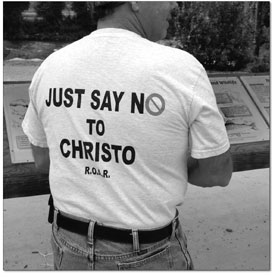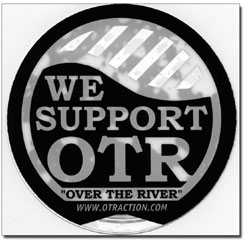| ||||
The appreciation gap
by Jules Masterjohn Gaps are all the rage. You know, distances between what is and what could be. They seem to be present in every sector of life. Well known is the generation gap; the ingenuity gap is found in the business world; insurance has the coverage gap; and education acknowledges the technology gap. Not to be left out, the art world has a gap, too. Let’s call it the “appreciation gap.” It describes the deep divide between the art we are comfortable with and that which we are not. It is the intellectual and emotional terrain concerning the art we feel at home with and the art that brings up questions about home. My guess is that as long as art has been viewed in public places, such a chasm has existed. Michelangelo’s sculpture “David” was one of the first works to fall into the appreciation gap, the 16-foot nude male offended some for its anatomical correctness and caused public controversy because of its political symbolism. Likewise, Impressionist painters such as Monet, Renoir and Cezanne were not well received by the art establishment in late 19th century France. The term “impressionism,” first given to their style of art by an art critic, was intended as a derisive label but later adopted by the artists. Modernity was to challenge French culture on yet another front. A controversy raged over the construction of the Eiffel Tower for the World’s Fair of 1889. Important cultural figures of the day, “writers, painters, sculptors, architects, lovers of the beauty of Paris,” mounted an opposition and a letter addressed to the World’s Fair director was printed in a Paris newspaper, stating: “… we are arguing one only needs to imagine for a moment a tower of ridiculous vertiginous height dominating Paris … its barbarous mass overwhelming and humiliating all our monuments and belittling our works of architecture … we shall see spreading like an ink stain, the odious shadow of this odious column of bolted metal.” has clearly been bridged: the Eiffel Tower is the most recognized monument in Europe with more than 200 million visitors since it opened in 1889. Here in Colorado, the appreciation gap is widening. The force behind this opening is the legendary artistic team, Christo and Jeanne-Claude, and their outdoor site-specific artwork, “Over the River.” This temporary installation includes 6 miles of translucent fabric panels intermittently suspended above a 40-mile stretch of the Arkansas River between Salida and Cañon City. I recently traveled to Salida to attend one of Christo and Jean Claude’s public presentations. Hearing that the project’s dissenters planned to be in the audience, I wanted to listen to their objections to better understand the dynamics at work.
One of the first sights upon arrival at the Steam Plant Theater in Salida was a fellow wearing a T-shirt that read: “Just say ‘NO’ to Christo,” the slogan used by the organized opposition, R.O.A.R. (“Rags Over the River.”) Jeanne-Claude believes that people are inherently “afraid of the new, afraid of what they do not understand.” Those in opposition believe that this project will cause harm to them and their environment. For these people, even the Environmental Impact Statement (EIS), paid for by the artists, seems not to assuage their fears. This 2,000-plus page document, now under review by the Bureau of Land Management, addresses the possible impacts of the project to the area, from the road congestion during the artwork’s two-week viewing period to the affected animal habitat. From the EIS, the government scientists and engineers will tell the artists what modifications, if any, can be undertaken to ensure the safety and welfare of the beings that use the river corridor…animals and humans alike. As their project manager told a concerned audience member, “The Colorado Department of Transportation will not allow the project to go forward if it cannot be done safely.” Without approval by all Colorado departments with jurisdiction over the impacted areas, the necessary permits will not be granted. No permits, no art. One gentleman, in an effort to filibuster the Q & A session after the Christos’ presentation, went on for many minutes, calling into question the artists’ integrity. Finally, an audience member called out, “Get to your question!” After a few more finishing arguments, he accused the team of lying about the clean-up of their past Colorado project, Valley Curtain, erected over Rifle Gap in 1972. He challenged the audience to go to the site and “see for yourselves” the massive concrete structures that still remain on the mountainside. With calm in her voice and a twinkle in her eye, Jeanne-Claude clarified that the structures remained in place at the request of the landowners on whose property the Valley Curtain was tethered. “They had such strong affection for the project, they asked us to leave the buttresses in place, as a reminder. And we have a contract with each landowner that states, if ever in the future they want the concrete removed, we will do so at our own cost.” Christo and Jeanne-Claude are certain that the controversy that has surrounded every large-scale project they have completed, 19 to date, only makes their work more powerful, interesting and important. Theirs is a new art form, one that challenges our notions about what art is, who makes it, and where it should be seen. With a clarity of vision that it takes to champion 21st century art, Christo offers, “The art is not only the fabric panels but it is all the reports, the 2,000-page EIS, and the meetings, the many meetings like this one. You here tonight, you are all part of our art, whether you like that or not.” • For more information on the work of Christo and Jeanne-Claude, visit www.chris tojeanneclaude.net and to read the interview, “Christo and Jeanne-Claude Unwrapped,” November 2006 issue, go to www.national geographic.com, National Geographic Magazine, Archives, November 2006, Online Extras.
|
In this week's issue...
- September 11, 2025
- Back on top
After harrowing flying accident, local highliner steps back out with renewed mission
- September 11, 2025
- New order
Rule change for Land and Water Conservation Fund raises alarms
- September 4, 2025
- Armed with knowledge
Local community organizers work to ensure immigrant neighbors know their rights



